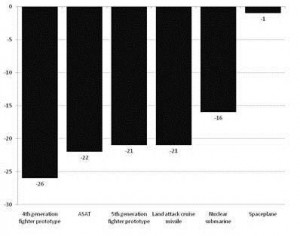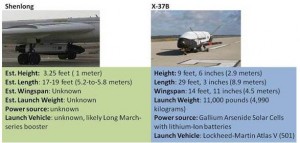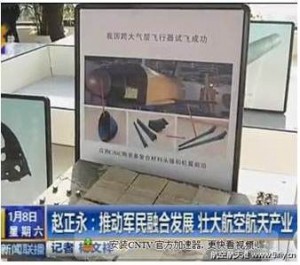China SignPost™ (洞察中国) #58–“Shenlong ‘Divine Dragon’ Takes Flight: Is China developing its first spaceplane?”
Andrew S. Erickson and Gabriel B. Collins, “Shenlong ‘Divine Dragon’ Takes Flight: Is China Developing its First Spaceplane?” China SignPost™ (洞察中国) 58 (4 May 2012).
China SignPost™ 洞察中国–“Clear, high-impact China analysis.”©
The age of the spaceplane upon us, and it is trans-Pacific, with the U.S. and China the only current active participants. Winged spaceplanes operate as spacecraft in space and aircraft in Earth’s atmosphere, and typically land on runways. They range from hypersonic cruise vehicles (HCV) capable of maneuvering at Mach 5 (3,840+ mph/6,150+ kmh) or more to reusable launch vehicles (RLV)s like the Space Shuttle designed primarily to ferry cargo to orbit and back.
Defense Advanced Research Projects Agency (DARPA) has just released details on the 11 August 2011 test flight of the Force Application and Launch from the Continental U.S. (FALCON) Hypersonic Technology Vehicle 2 (HTV-2). Constructed by Lockheed Martin Corp., this HCV is part of a multiyear DARPA effort to develop an air-breathing platform that could deliver a payload at Mach 20 (~13,000 mph) via near-space altitudes anywhere in the world within an hour.
While valuable test results were obtained, and HTV-2 reached its planned speed, the flight ended after 9 minutes rather than the planned 30 with an ocean impact far short of the Kwajalein Atoll, whose vicinity it had been hoped to reach from Vandenberg Air Force Base near Santa Barbara, CA. Shockwave-induced skin peel and resulting destabilization of the vehicle ended that plan. A previous test flight occurred 22 April 2010, its conclusion similarly premature. No future test flight plans have been scheduled, apparently, leaving the program’s future uncertain.
More promisingly, Boeing’s X-51 WaveRider unmanned supersonic combustion ramjet (scramjet) demonstrator aircraft achived Mach 5 free flight from a B-52 bomber off California’s coast on 26 May 2010. A 13 June 2011 test flight succumbed to engine problems, however. A collaborative effort among the U.S. Air Force (USAF), DARPA, NASA, Boeing, and Pratt & Whitney Rocketdyne, it is run by the USAF Research Laboratory’s Propulsion Directorate.
Most successfully, Boeing’s X-37 Orbital Test Vehicle (OTV) has been tested three times without incident. Designed to conduct experiments and send satellite sensors and related technology to and from space, the X-37B is a vertical-takeoff, horizontal-landing spaceplane designed to examine and repair satellites in low earth orbit (LEO). Based on NASA’s X-37 design, and drawing on DARPA inputs, the program is run by the USAF. On 5 March 2011, in the USA-226 mission, the second X-37B OTV was launched into LEO from Cape Canaveral, where it has been ever since. The first orbital mission began on 22 April 2010 and ended successfully at Vandenberg 225 days later on 3 December 2010. A third is planned for fall 2012. Prior to these missions, only the Soviet Buran reusable orbital vehicle had performed an automated post-orbital landing, after returning from a two-orbit flight on 15 November 1988. Now Boeing is planning a larger X-37C version.
Meanwhile, across the Pacific, Beijing may be entering the spaceplane era faster than many would have predicted. A similarly-militarily-relevant system appears to be emerging with the development of China’s own vehicle. Multiple Chinese-language media outlets state that on 8 January 2011, China completed a test flight of the Shenlong (神龙/Divine Dragon) spaceplane.
The test flight announcement from a Sha’anxi TV station came within a month of the U.S. X-37B orbital vehicle’s return to earth after its first test flight and come almost simultaneously with China’s test flight of its J-20 fighter prototype. This reflects China’s growing technical proficiency in the aerospace sector. It hints at China’s pursuit of space systems that can potentially switch quickly between civilian and military missions.
Shenlong’s test also reflects a shrinking time gap between when the U.S. first reveals a prototype military system and when China publicly shows a system comparable in type (if not equivalent in capabilities or immediately operational). For previous aerospace developments, China typically revealed its systems’ existence at least 15 years after the U.S. first showed its analogous platforms (Exhibit 1).
The immediate implication is that in some areas of space operations, China may be attempting to emulate the U.S. and develop advanced capabilities that could give it strategic advantages; as well as to reveal selected development efforts in order to further patriotism at home and deterrence abroad. Given the high U.S. reliance on space-based C4ISR capabilities, Chinese space platform developments such as Shenlong warrant close attention.
Exhibit 1: Gap in years between first unveiling of select U.S. and Chinese weapons systems
Source: China’s Defence Today, USAF, Southern Weekend, Chinese Internet
Shenlong’s development
Data on the Shenlong program remain sparse in both English and Chinese-language sources. Perhaps drawing on its successful and wide-ranging R&D on extended-range cruise missiles, China’s defense establishment also appears to conducting conceptual design work on HCVs. At an international conference in 2006, experts from China Academy of Launch Vehicle Technology (CALT) asserted that RLVs represent “the main trend of space transportation system[s].”
With respect to new-generation Long March launch vehicles, they offered a “RLV roadmap… including development goals, system concepts, and approach[es] for maturing key technologies.” The researchers stated that CALT would decide whether to develop an RLV within the next few years, and possibly select between “two system architectures,” both of which entailed “taking off vertically, landing horizontally, two stage to orbit, and partially reusable.”
One Chinese study has outlined the results of modeling and simulation of a scramjet-powered vehicle with a range of between 1,000-2,000 km, flying toward its target at an altitude of between 25-30 km and speed of Mach 6. Mark Stokes tells us that scramjet engine testing may be underway at China Aerodynamics Research and Development Center (CARDC, 中国空气动力研究与发展中心) in Mianyang, Sichuan. Another study focused on a HCV adopting a skipping trajectory with an upper altitude of 60 km and lower altitude of 30 km. In addition to researching optimal design methods, and addressing specific guidance, navigation, and control issues, Chinese aerospace engineers also have been carrying out basic research into an air-turbo rocket (ATR) propulsion system, an air-breathing system that combines elements from both turbojets and rocket engines. Simulations validated one design that operates at speeds up to Mach 4 and altitudes of up to 11 km.
As for Shenlong specifically, Chinese sources say it is part of the 863 State High-Tech Development Plan (国家高技术研究发展计划) and that the People’s Liberation Army (PLA) considers it a priority system for development. In October 2006, Jane’s states, China Aerospace Science and Technology Corporation (CASC) displayed an Air-launched Satellite Launch Vehicle (ASLV) three-stage solid propellant vehicle model. It had dual small delta-shaped wings, similar to the U.S. Pegasus air-launched SLV. Chengdu Aircraft Corporation’s 611 Institute led Shenlong’s design and testing, according to Jane’s. Jane’s also believes the Nanjing University of Aeronautics and Astronautics, Northwest University, and the Harbin Technical University assisted in the craft’s design and testing.
Today the CASC First Academy contains a new shop, the 10th Research Institute (Near Space Flight Vehicle Research Institute), devoted to HCV design. Formerly chief designer of a major solid fueled ballistic missile system, Director Bao Weimin [包为民] also enjoys influence as CASC First Academy S&T Committee Director, head of the PLA/General Armaments Department (GAD)’s General Missile Technology Expert Working Group, and deputy director of the PLA/GAD Precision Guidance Expert Group under the 863-4 Advanced Defense (先进防御) projects series.
According to Mark Stokes and Dean Cheng, “The establishment of such a separate research institute – one that focuses on a single capability – within China’s premier launch vehicle and ballistic missile academy serves as a prominent indicator of the priority that senior civilian and military leaders place on new generation long-range precision strike vehicles.”
Physical dimensions
In its currently observable configuration, at least, Shenlong appears much smaller than America’s X-37B. We are not aware of any Chinese sources disclosing Shenlong’s precise dimensions. Based on available photos, we estimate that its body is roughly 1 meter tall, with a length of between 5 and 6 meters (Exhibit 2). As such, it is likely only about 1/3 the size of the X-37B. By contrast, Jane’s estimates larger dimensions of 1.1 m and 12.0 m respectively, with a 4.0 m wingspan, though this might apply to another three-stage ALSV variant. The disparity could be caused by several different factors, including the possibility that:
–The 2006 model was refined into a smaller real world version due to engineering considerations;
–The existence of a smaller version in 2006 was considered sensitive and thus was not publicly disclosed at the same time;
–There are two different versions (large/small) with differing missions;
For example, the larger version ASLV may enable insertion to geostationary orbit (GEO), whereas the smaller Shenlong need only reach LEO, and
–Payload miniaturization may have resulted in a smaller launch configuration, allowing for lower cost and opportunity to build more vehicles for flexibility.
Indeed, the existence of three separate U.S. HCV programs suggests both a range of programmatic possibilities and direct sources of inspiration for China. In any case, Shenlong’s small size may have been dictated in part by the ability of the H-6 bomber to carry it under its fuselage, attached by a specialized pylon. Images of an alleged Shenlong spaceplane prototype have a body configuration remarkably similar to a small version of the U.S. Space Shuttle or the X-37B (Exhibit 3).
Exhibit 2: Shenlong as compared to X-37B
Source: Chinese Internet, China SignPost™, USAF
Exhibit 3: Alleged images of new Chinese spaceplane prototype
Caption at top of slide reads “China’s trans-atmospheric vehicle tested successfully”
Source: Chinese Internet
According to Jane’s, Shenlong may have INS/GPS navigation. It is reportedly designed to be launched from an H-6 at an altitude of ~10 km. Following ignition, a first-stage motor would take the 13,000 kg spacecraft to 490 km in ~8 minutes before a second stage burn would take it to 600 km altitude. A third stage would then accelerate the spacecraft prior to dispensing a satellite of ~50 kg into sun-synchronous orbit before landing on a runway in its return to Earth. These parameters might apply to Shenlong or an ASLV variant thereof, and it is possible that the current Shenlong vehicle is a technology demonstrator for the latter or even a different follow-on program.
Strategic Implications
At a minimum, Shenlong appears to be a technological development/validation program. A successful Chinese spaceplane program would have two key strategic implications. First, on the broad level, it would signify that the Chinese space program has come one step closer to being able to build a Space Shuttle-type capability. On a related note, further test flights, particularly if they involve X-37B-style maneuvering by a larger derivative of Shenlong, would also strongly suggest that China’s command and control system for space assets has become much more capable, with commensurate implications for both military and civil space operations. Which service would control Shenlong remains uncertain, as GAD, the PLA Air Force (PLAAF), and even the Second Artillery contend for control of operational space assets—and some Chinese thinkers argue for the formation of a separate Space Force (天军). Not surprisingly, as Kevin Pollpeter informs us, PLAAF-connected writers are already citing spaceplane development as yet another reason why their service should handle space operations.
Second, spaceplanes confer a number of capabilities that conventional launchers cannot offer. First of all, they are reusable and their payloads can be changed between missions. These features offer versatility and may even offer some cost savings, especially for reconnaissance missions. Rocket boosters for putting a spaceplane in orbit might cost ~US$150-200 million.
Spaceplane costs also include the spaceplane itself (with robust structure and shielding), extensive post-flight refurbishment, integration costs, possible manpower costs for flying the spaceplane, payload costs, and recovery costs. Launching a relatively small satellite with a spaceplane as opposed to on a single-use rocket may not realize large costs savings, but it is an option that Chinese planners would likely want to have available eventually.
Larger future iterations of Shenlong could materially enhance China’s space-based C4ISR capabilities through both on-board sensor systems and the ability to deploy microsatellites and other sensor systems that boost space situational awareness. Spaceplanes can also rapidly change orbits to hinder tracking, survey different areas, or potentially avoid an opponent’s anti-satellite (ASAT) systems. During its maiden flight, the X-37B was said to have changed orbits, confounding amateur spotters for several days until one located the craft in its new orbital path.
Finally, a spaceplane’s ground-based status could allow it to sidestep international agreements restricting the deployment of weapons in space and add to its appeal as a potential ASAT platform. Many Chinese writers see the X-37 program as evidence of American determination to develop anti-satellite (ASAT) capability and engage in a space arms race. At the same time, according to Stokes and Cheng, “China’s counterspace program appears to parallel interest in countermeasures [e.g., kinetic kill vehicles, as demonstrated in China’s 11 January 2007 ASAT test and 11 January 2010 missile defense test] against advanced U.S. long-range precision strike capabilities that would transit space, and are expected to be in place by 2025,” which might include the FALCON HTV, the X-37B, and the X-51A.
What is clear already is that China is pursuing an ambitious but methodical and well-funded space program. On 29 September 2011, for example, China launched its first space laboratory module, Tiangong-1 (天宫一号 “Heavenly Palace 1”). This experimental platform will be used to test rendezvous and docking capabilities needed to assemble a space station from a larger configuration of modules. China’s moves toward establishing a space station are attracting considerable attention, particularly as the U.S. retired its first (and, to date, only) manned spaceplane (the Space Shuttle) after just 135 missions with the touchdown of Atlantis on 21 July 2011, and now relies on Russian spacecraft to ferry its astronauts to the International Space Station.
Multimedia Sources
http://video.sina.com.cn/v/b/44970858-1304604555.html
http://www.tudou.com/programs/view/e_c2guok-gc/
About Us
China Signpost™ 洞察中国–“Clear, high-impact China analysis.”©
China SignPost™ aims to provide high-quality China analysis and policy recommendations in a concise, accessible form for people whose lives are being affected profoundly by China’s political, economic, and security development. We believe that by presenting practical, apolitical China insights we can help citizens around the world form holistic views that are based on facts, rather than political rhetoric driven by vested interests. We aim to foster better understanding of key internal developments in China, its use of natural resources, its trade policies, and its military and security issues.
China SignPost™ 洞察中国 founders Dr. Andrew Erickson and Mr. Gabe Collins have more than a decade of combined government, academic, and private sector experience in Mandarin Chinese language-based research and analysis of China. Dr. Erickson is an Associate Professor at the U.S. Naval War College’s China Maritime Studies Institute (CMSI) and an Associate in Research at Harvard’s John King Fairbank Center for Chinese Studies. Mr. Collins is a law student at the University of Michigan Law School. His research focuses on commodity, security, and rule of law issues in China, Russia, and Latin America.
The positions expressed here are the authors’ personal views. They do not represent the U.S. Naval War College, Navy, Department of Defense, or Government, and do not necessarily reflect the policies or estimates of these or any other organizations.
The authors have published widely on maritime, energy, and security issues relevant to China. An archive of their work is available at www.chinasignpost.com.








































